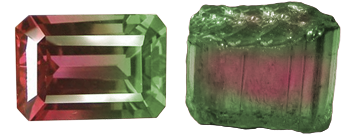 Photo of Watermelon Tourmaline in Processed & Rough Form
Photo of Watermelon Tourmaline in Processed & Rough Form
Watermelon Tourmaline is a mineral with a hardness of 8 out of 10 on the Mohs scale of mineral hardness [?]. These Trigonally structured gems are made of complex borosilicate, their full chemical compound being Na(Li,Al)3Al6(BO3)Si6O18(OH)4.
Watermelon Tourmaline is a bi-colored/tri-colored/parti-colored occurrence of Tourmaline, and this appearance is usually a feature of the variety known as Elbaite. When cut parallel to its base, this tourmaline exhibits a rose-red center, a very thin colorless band parallel to the surface of the crystal, and a brown or green outer layer.
In parti-colored tourmaline the core is nearly colorless and outer segments may be pink in one end, green at the other end. Parti-coloured stones tend to be more fragile at the boundary areas of each color. In bicolored, the core is colorless or green and outer segments are pink. In some tricolored tourmaline, the color is separated in three zones: the core is frequently pink or red and the outer ends are white and green or any combination of these colors.
Color zoning giving the familiar watermelon appearance with the red core and green rind is brought about by more than one event in the genesis of the tourmaline crystal, including a change of composition during its growth. Colours that are visible in a single crystal range from pink to pale green, pale to deep blue (in the ordinary ray); in the extraordinary ray the crystals may show colorless to yellow, olive blue or purple.
All tourmalines have good resistance to weathering and are often found in alluvial areas, with mixtures of clay, sand, silt and gravel.
The finest elbaites come from Elba (Italy), the Urals (Russia), Sri Lanka, Namibia, Mozambique, Madagascar, Newry, Maine, and Pala, California (USA). In Nigeria, the pegmatites southeast of Keffi in western Plateau state have produced green, pink, red, violet, yellow and watermelon elbaite tourmalines. In Brazil it is known as Boco de fogo.
The specific gravity [?] for Watermelon Tourmaline is 3.06, it's refractive index [?] is 1.62-1.64, and it's double refraction [?] is 0.018.
History
Watermelon tourmaline takes its name from its concentrically-zoned appearance, typically red on the inside, and green on the outside, which when cut, looks like sliced watermelon.
Industrial Usages
Other varieties of tourmaline are maximized for their piezoelectric property. But colored and transparent varieties of elbaite tourmaline are widely sold as semiprecious stones.
The watermelon type of concentrically-zoned tourmaline material is often fashioned as thin, polished slabs for use in drop earrings and cuff-links.






